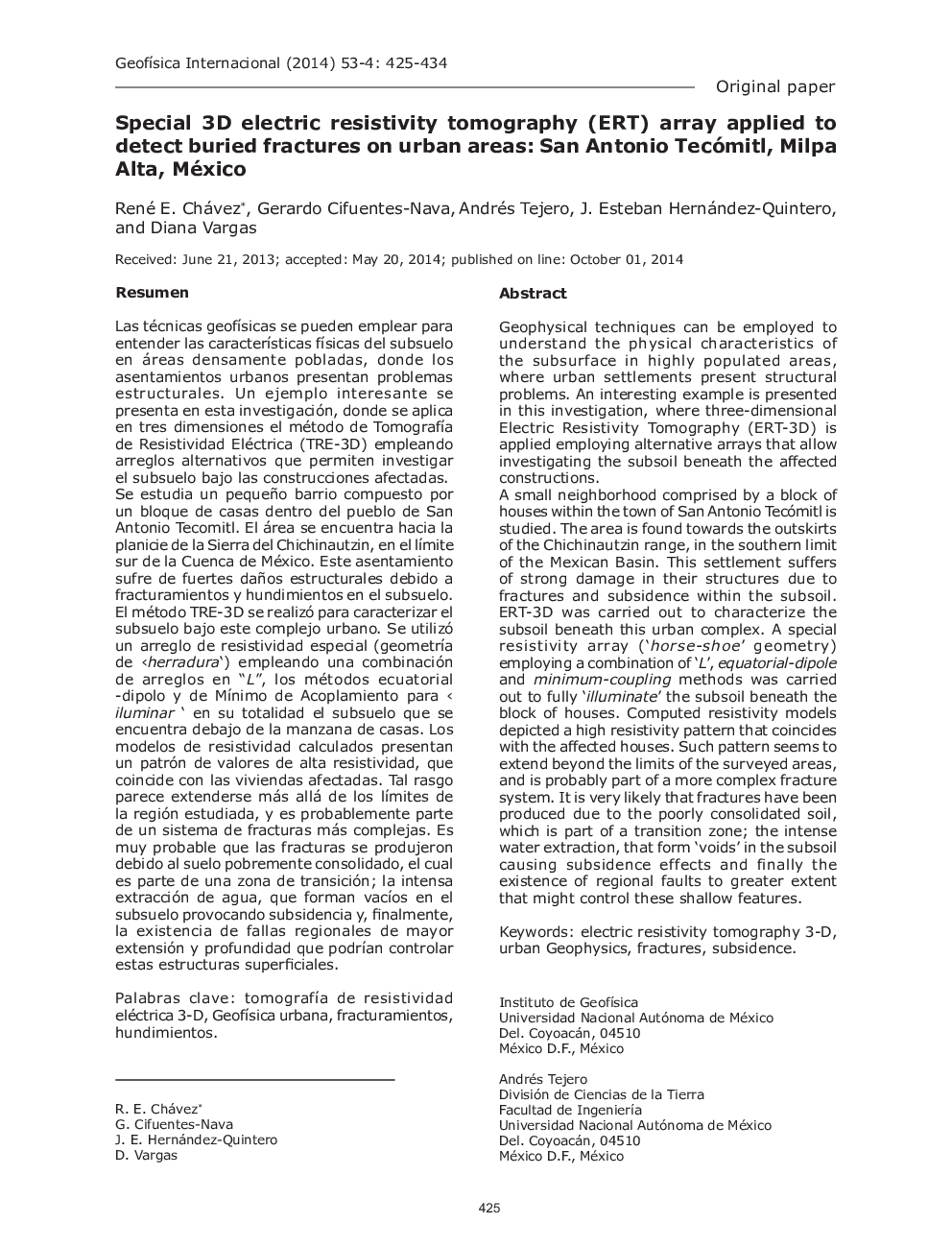| کد مقاله | کد نشریه | سال انتشار | مقاله انگلیسی | نسخه تمام متن |
|---|---|---|---|---|
| 4674347 | 1347148 | 2014 | 10 صفحه PDF | دانلود رایگان |

ResumenLas técnicas geofísicas se pueden emplear para entender las características físicas del subsuelo en áreas densamente pobladas, donde los asentamientos urbanos presentan problemas estructurales. Un ejemplo interesante se presenta en esta investigación, donde se aplica en tres dimensiones el método de Tomografía de Resistividad Eléctrica (TRE-3D) empleando arreglos alternativos que permiten investigar el subsuelo bajo las construcciones afectadas.Se estudia un pequeño barrio compuesto por un bloque de casas dentro del pueblo de San Antonio Tecomitl. El área se encuentra hacia la planicie de la Sierra del Chichinautzin, en el límite sur de la Cuenca de México. Este asentamiento sufre de fuertes daños estructurales debido a fracturamientos y hundimientos en el subsuelo. El método TRE-3D se realizó para caracterizar el subsuelo bajo este complejo urbano. Se utilizó un arreglo de resistividad especial (geometría de ‹herradura') empleando una combinación de arreglos en “L”, los métodos ecuatorial -dipolo y de Mínimo de Acoplamiento para ‹iluminar' en su totalidad el subsuelo que se encuentra debajo de la manzana de casas. Los modelos de resistividad calculados presentan un patrón de valores de alta resistividad, que coincide con las viviendas afectadas. Tal rasgo parece extenderse más allá de los límites de la región estudiada, y es probablemente parte de un sistema de fracturas más complejas. Es muy probable que las fracturas se produjeron debido al suelo pobremente consolidado, el cual es parte de una zona de transición; la intensa extracción de agua, que forman vacíos en el subsuelo provocando subsidencia y, finalmente, la existencia de fallas regionales de mayor extensión y profundidad que podrían controlar estas estructuras superficiales.
Geophysical techniques can be employed to understand the physical characteristics of the subsurface in highly populated areas, where urban settlements present structural problems. An interesting example is presented in this investigation, where three-dimensional Electric Resistivity Tomography (ERT-3D) is applied employing alternative arrays that allow investigating the subsoil beneath the affected constructions.A small neighborhood comprised by a block of houses within the town of San Antonio Tecómitl is studied. The area is found towards the outskirts of the Chichinautzin range, in the southern limit of the Mexican Basin. This settlement suffers of strong damage in their structures due to fractures and subsidence within the subsoil. ERT-3D was carried out to characterize the subsoil beneath this urban complex. A special resistivity array (‘horse-shoe’ geometry) employing a combination of ‘L’, equatorial-dipole and minimum-coupling methods was carried out to fully ‘illuminate’ the subsoil beneath the block of houses. Computed resistivity models depicted a high resistivity pattern that coincides with the affected houses. Such pattern seems to extend beyond the limits of the surveyed areas, and is probably part of a more complex fracture system. It is very likely that fractures have been produced due to the poorly consolidated soil, which is part of a transition zone; the intense water extraction, that form ‘voids’ in the subsoil causing subsidence effects and finally the existence of regional faults to greater extent that might control these shallow features.
Journal: Geofísica Internacional - Volume 53, Issue 4, October–December 2014, Pages 425–434